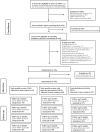The effect of neck-specific exercise with or without a behavioral approach on psychological factors in chronic whiplash-associated disorders: A randomized controlled trial with a 2-year follow-up
- PMID: 27559950
- PMCID: PMC5400316
- DOI: 10.1097/MD.0000000000004430
The effect of neck-specific exercise with or without a behavioral approach on psychological factors in chronic whiplash-associated disorders: A randomized controlled trial with a 2-year follow-up
Abstract
Background: To investigate the effect of neck-specific exercise with (NSEB) or without (NSE) a behavioural approach and prescribed physical activity (PPA) on general pain disability and psychological factors in chronic whiplash-associated disorders (WAD), grade 2 and 3, with a 2-year follow-up.
Methods: A randomized controlled multi-centre study of 3 exercise interventions (NSE, NSEB or PPA) including a 2-year follow-up. A total of 216 volunteers with chronic WAD were recruited and 194 were analyzed, mean age 40.4 (Standard Deviation [SD] 11.4). Measures of general pain disability, pain catastrophizing, anxiety and depression, and kinesiophobia were evaluated at baseline, and 3, 6, 12 and 24 months with linear mixed models.
Results: General pain disability decreased by 28% in the NSEB group from baseline to 3 months (P < 0.001) and the improvements in disability were maintained over time (6, 12 and 24 months P < 0.01) compared to the NSE (P > 0.42) and PPA groups (P > 0.43). Pain catastrophizing decreased in the NSE group from baseline to 6 and 12 months (P < 0.01) and in the NSEB group from baseline to 3 and 24 months (P < 0.01) compared to the PPA group (P > 0.82) that showed no change over time. The NSE group improved in kinesiophobia over time from baseline to12 months (P < 0.01) compared to the NSEB (P = 0.052) and the PPA groups (P > 0.74). Anxiety decreased over time from baseline to 12 and 24 months in the NSE group (P > 0.02), but not in the NSEB (P > 0.25) or the PPA (P > 0.50) groups. The PPA had no effect on general disability or any of the measured psychological factors.
Conclusion: This randomised controlled trial with a 2-year follow-up shows that physiotherapist-led neck-specific exercise with or without the addition of a behavioural approach had superior outcome on general disability and most psychological factors compared to the mere prescription of physical activity.
Conflict of interest statement
The authors have no conflicts of interest to disclose.
Figures
References
-
- Holm LW, Carroll LJ, Cassidy JD, et al. The burden and determinants of neck pain in whiplash-associated disorders after traffic collisions: results of the Bone and Joint Decade 2000–2010 Task Force on Neck Pain and Its Associated Disorders. Spine 2008; 33 (4 suppl):S52–S59. - PubMed
-
- Agnew L, Johnston V, Landen Ludvigsson M, et al. Factors associated with work ability in patients with chronic whiplash-associated disorder grade II-III: a cross-sectional analysis. J Rehabil Med 2015; 47:546–551. - PubMed
-
- Spitzer WO, Skovron ML, Salmi LR, et al. Scientific monograph of the Quebec Task Force on Whiplash-Associated Disorders: redefining “whiplash” and its management. Spine 1995; 20 (8 suppl):1S–73S. - PubMed
-
- Nijs J, Van Oosterwijck J, De Hertogh W. Rehabilitation of chronic whiplash: treatment of cervical dysfunctions or chronic pain syndrome? Clin Rheumatol 2009; 28:243–251. - PubMed
-
- Walton DM, Macdermid JC, Giorgianni AA, et al. Risk factors for persistent problems following acute whiplash injury: update of a systematic review and meta-analysis. J Orthop Sports Phys Ther 2013; 43:31–43. - PubMed
Publication types
MeSH terms
LinkOut - more resources
Full Text Sources
Other Literature Sources
Medical


